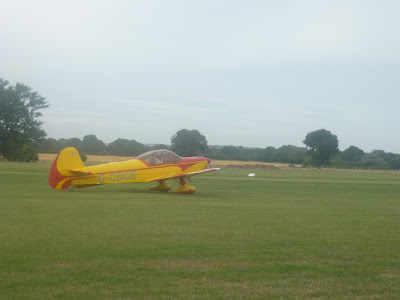I took the day off from work on Friday and with my old PPL instructor popped over to Le Touquet in his C172. The trip only took an hour and is a straight forward enough route. However the sense of adventure comes from it being cross channel and the additional preparation you have to go through before setting off. I hope I get the opportunity to go many times again in the future.

The weather on Friday was fine here in the UK but at Le Touquet the cloud base was broken at 800ft. After a few chats and an hour or so later it was improving and so I decided to go for it. Mike had filled the flight plan the previous evening for a 10:45 Local time departure. At the same time he had logged the return. This left the GAR (General Aviation Report) form for customs and special branch requirements in the UK and a two other things. one, an email to the destination for PPR (Prior Permission Required) and the other an email for french customs. As the same type of information is needed by both I merely sent the same email to both addresses. I have to say I didn't get a response from either of them (customs@aeroport-letouquet.com and bsi-bouglne@douane.finances.gouv.fr)

Heading off from base was a pretty standard drill and I was to track down to the Dover VOR leaving Rochester around the Faversham area and switching to Manston radar. Rochester activated the flight plan which they advised us of as we were climbing out from runway 20. In speaking with Manston I advised them of the route as I would normally do (i.e. from, to part of the message) and then also of the fact I would be routing via Dover and my ETA there. One addition item they like apparently is the ETA at the FIR boundary. Once at the coast I called 'coasting out Dover, climbing 3,500 feet'. I was told to report mid channel which I did and was then directed to "freecall Le Touquet Tower". I routed over to Cap Gris Nez and altered heading by turning right to track down the coast. The ATC at Le Touquet were very friendly and welcomed us onto the frequency asking us to "report at calling point November". As we were above cloud from pretty much mid channel this meant consulting the Le Touquet Visual Approach documentation for the calling points and of course our GPS unit (we had 4 - the one I was using was SkyDemon running on an iPAD).

We tracked to the right of the coastline and headed down to Boulogne making the position call. I think at this point they advised of the conditions at the aerodrome and the runway in use which was 32. I started the descent at this point, gradually descending through cloud keeping a vigilant eye on the attitude indicator and making gentle heading corrections. This part went quite well actually.
Once at Le Touquet we approached from the coast side of the ATZ (Sainte-Cecile Beach) and joined at the beginning of what would be the downwind leg. I was number 4 in the circuit and could just make it around the circuit at about 950 feet (nearly circuit height). Moving around the landing was OK although there was a bit of crosswind which seemed to knock me off a little while on the ground. A bit of directional instability occurred caused by over correcting on my part.
After taxing to a stop on the apron we headed to the rather nice restaurant situated on the airport for a what was an enjoyable lunch. I couldn't pay my landing fees when we arrived as there was nobody on reception but on our way out it was staffed so I paid my fee. They hadn't recored our arrival for some reason but this was soon cleared up.
Heading home, the route was the same although we were slightly inland (tracking up the coast but keeping it to our left). When leaving Le Touquet they sent us to Lille Info, who at Mid Channel told us to go to London Info however I wanted to go to Manston so advised them that this was our preference. They obliged, approving the change and wished us well.
Going back over the channel we crossed at 4,500 ft. When at Dover I called that I was "coasting in at Dover". It was explained to me that these two new calls (coasting out and coasting in) were useful as the route from Dover to Cap Gris Nez is the shortest over water and for this reason is very popular. As a result, these calls tell everybody where you are and what you are doing. Makes sense.
The journey back from here was standard stuff joining crosswind at Rochester for runway 20.
All in all a great day out and very useful experience for me. I hope to repeat some time in the future with my family.
Rochester to Le Touquet Brakes Off 11:10 Brakes On 12:15 - 1:05
Le Touquet to Rochester Brakes Off 14:40 Brakes On 15:45 - 1:05
HOURS = 51:15 DUAL + 21:00 PIC [P1] + 2:10 [PICUS]
Total Time = 74:25
 Brakes Off: 09:05 Brakes On: 10:05
Brakes Off: 09:05 Brakes On: 10:05
























